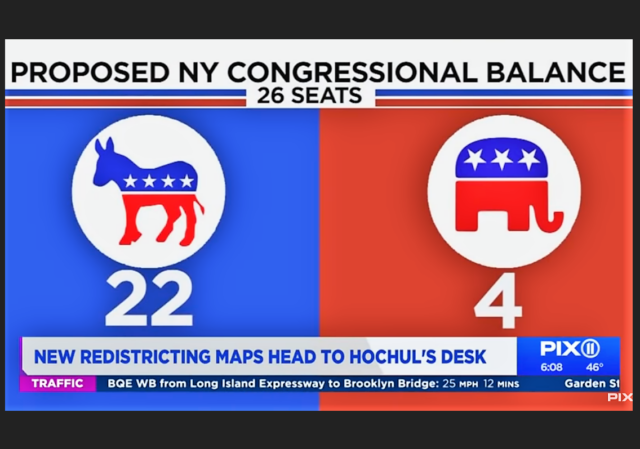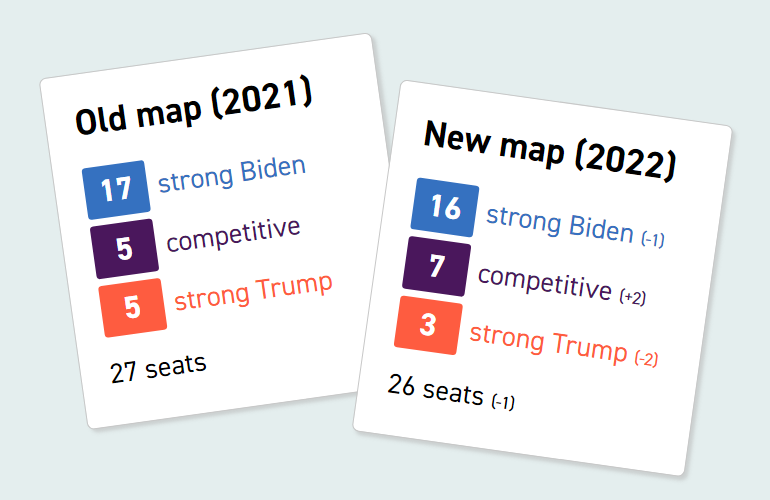NY Dems Get Another Run At Redistricting Republicans Out of Existence After Mid-Level Appeals Court Orders New Mapping

If at first you don’t succeed, try try again.
That’s the Democrats’ motto in New York State when it comes to redistricting. We covered the story in the run up to the 2022 elections. When the supposedly non-partisan state election commission deadlocked over redistricting, Democrats who control the state legislature so furiously and outrageously gerrymanderred the redistricting map so as to all but eliminate the Republican congressional delegation. The state’s highest court, the Court of Appeals, found the actions violated the NY State constitution. The Court of Appeals ordered that maps prepared by a neutral expert hired by the Court be used.
We covered the story in New York High Court Throws Out Democrat Gerrymandered Congressional Map “Drawn With An Unconstitutional Partisan Intent”. From the Opinion:
In 2014, the People of the State of New York amended the State Constitution to adopt historic reforms of the redistricting process by requiring, in a carefully structured process, the creation of electoral maps by an Independent Redistricting Commission (IRC) and by declaring unconstitutional certain undemocratic practices such as partisan and racial gerrymandering. No one disputes that this year, during the first redistricting cycle to follow adoption of the 2014 amendments, the IRC and the legislature failed to follow the procedure commanded by the State Constitution. A stalemate within the IRC resulted in a breakdown in the mandatory process for submission of electoral maps to the legislature. The legislature responded by creating and enacting maps in a nontransparent manner controlled exclusively by the dominant political party — doing exactly what they would have done had the 2014 constitutional reforms never been passed. On these appeals, the primary questions before us are whether this failure to follow the prescribed constitutional procedure warrants invalidation of the legislature’s congressional and state senate maps and whether there is record support for the determination of both courts below that the district lines for congressional races were drawn with an unconstitutional partisan intent. We answer both questions in the affirmative and therefore declare the congressional and senate maps void. As a result, judicial oversight is required to facilitate the expeditious creation of constitutionally conforming maps for use in the 2022 election and to safeguard the constitutionally protected right of New Yorkers to a fair election.
Those maps achieved the intended purpose, minimal redistricting and competitive districts. Republicans ended up gaining four seats, but not because of gerrymandered maps, because of voters.
Democrats hated that, so they put their go-to election lawyer, Marc Elias, on the case, and he just obtained a coup d’etat from the state’s mid-level appellate court, the Appellate Division. The Appellate Division asserted that the Court of Appeals decision was only intended for one election cycle, 2022, and was not meant to be a redistricting for the entire census cycle (10 years). So the Appellate Division ordered the state redistricting commission to issue new maps.
From the Appellate Division 2-1 majority Opinion:
In support of their claim for mandamus relief, petitioners argue that, under the plain language of the NY Constitution, the IRC has a nondiscretionary duty to submit a second set of redistricting plans to the Legislature if its first set of plans is rejected by legislative vote. Petitioners assert that Harkenrider exclusively addressed the Legislature’s constitutional violations and, thus, did not remedy the IRC’s failure to perform that duty. They further claim that, because the court-ordered congressional map adopted in Harkenrider was merely an interim map for the purpose of the 2022 elections, they have a clear legal right to the performance of that duty.Against the backdrop of the 2014 redistricting reforms, these arguments are compelling….Instead, the reforms were thwarted, and these goals were not met. As petitioners’ counsel repeatedly asserted at oral argument, this proceeding seeks to “vindicate the purpose” of the redistricting amendments. In addition to evaluating the various constitutional provisions cited to by the parties, we are now in the uncomfortable position of discerning what the Court of Appeals intended by its silence regarding the critical issue of the duration relative to the judicial remedy it imposed. We are necessarily limited in our ability to infer such intention in this delicate and highly charged matter of significant public concern….To interpret the Court’s decision as further diverting the constitutional redistricting process, such that the IRC cannot now be called upon to do its duty, would directly contradict this express limiting language in the provision that grants the courts the power to intervene. Simply put, the Court was not “required” to divert the constitutional process beyond the then-imminent issue of the 2022 elections. For these several reasons, in the complete absence of any explicit direction, we decline to infer that the Court intended its decision to have further ramifications than strictly required.
The Dissent rejected the notion that for decennial census redistricting the Court of Appeal meant only a one election cycle redistricting:
At the outset, we reject petitioners’ contention, with which the majority agrees, that the courtordered congressional map is interim – in place only for the purpose of the 2022 elections – rather than in place until after the 2030 census. Indeed, determination of this issue is crucial as the mandamus relief sought is hard-tethered to the duration of the relief ordered in Harkenrider. To that end, we disagree with the majority’s position that the Court of Appeals, in Harkenrider, left us “in the uncomfortable position of discerning what the Court of Appeals intended by its silence regarding the critical issue of the duration relative to the judicial remedy it imposed.” To the contrary, the plain language of the NY Constitution provides the duration in clear terms. “The process for redistricting congressional and state legislative districts [established by NY Constitution, article III, §§ 4, 5 and 5-b] shall govern redistricting in this state except to the extent that a court is required to order the adoption of, or changes to, a redistricting plan as a remedy for a violation of law. A reapportionment plan and the districts contained in such plan shall be in force until the effective date of a plan based upon the subsequent decennial census taken in a year ending in zero unless modified pursuant to court order” (NY Const, art III, § 4 [e]). The Court of Appeals directly cited to, and thereby incorporated, this section when discussing and approving the judicially drawn maps ordered by Supreme Court; “[t]hus, we endorse the procedure directed by Supreme Court to ‘order the adoption of . . . a redistricting plan’ ” (Matter of Harkenrider v Hochul, 38 NY3d at 523, quoting NY Const, art III, § 4 [e]). Notably, there is no caveat nor limitation as to duration and, as such, it is our opinion that the Constitution requires that such court-ordered maps remain in place until after the next census (see NY Const, art III, § 4 [e]). More to the point, the courts could have – yet did not – expressly order that the plan adopted in Harkenrider be interim and only remain in place until the IRC took action and implemented a legislative plan that met constitutional requirements following the 2022 election….
Even the NY Times knows what comes next unless the Court of Appeals reverses – the election commission deadlocks again, and the Democratic legislature tries again to redistrict Republicans of existence:
Democrats filed a new lawsuit last year, paid for by the Democratic Congressional Campaign Committee, arguing that those maps were meant to be temporary and asking the courts to force the bipartisan commission to complete its work.Though the commission would have the first shot at drawing the new maps under Thursday’s ruling, both parties expected the panel to deadlock again. That would send the final mapmaking authority back to the Legislature — only this time with the blessing of the courts.Republicans are trying to block that possibility. On Thursday, party leaders said they would appeal.“The Court of Appeals must overturn this ruling, or Democrats will gerrymander the map to target political opponents and protect political allies,” Representative Elise Stefanik said in a joint statement with Edward Cox, the top New York House Republican and state party chairman.
CLICK HERE FOR FULL VERSION OF THIS STORY
